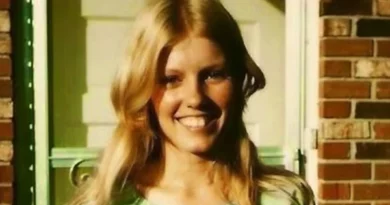Jodi Huisentruit Disappeared On Her Way to News Anchor Job in Mason City Iowa
On Tuesday, June 27, 1995, twenty-seven-year-old morning news anchor Jodi Sue Huisentruit vanished from the parking lot of her Mason City, Iowa apartment complex while leaving for work at KIMT-TV. In the hours that followed, colleagues discovered a disturbing scene around her red Mazda Miata—personal items strewn on the pavement, a bent car key, and clear indications that a struggle had taken place. Within days, the case gripped the Midwest and then the nation. Decades later, with no arrest and no remains recovered, the disappearance of Jodi Huisentruit remains one of America’s most haunting unsolved cases.
Who Jodi Was
Raised in Long Prairie, Minnesota, Jodi was known for her upbeat energy, competitive spirit in school athletics, and relentless work ethic. After college and early on-air roles in the Upper Midwest, she landed the morning and noon anchor chair at KIMT in Mason City. Colleagues and viewers alike remember a personable host who connected easily with people on and off camera. Friends describe her as socially active—often golfing, water-skiing, and attending community events—but also intensely career focused. The path she was on suggested a likely transition to a larger television market in time. It is precisely this blend of visibility, routine, and ambition that frames why her disappearance drew such immediate attention and why her case continues to resonate with journalists and audiences.
The Final 24 Hours
The day before she disappeared, Jodi kept a schedule typical for a morning anchor coming off a weekend: socializing after work hours, touching base with friends, and preparing to be at the station well before dawn. Her weekday routine—wake up around 3:00–3:30 a.m., leave the apartment complex shortly after 4:00 a.m., and anchor the morning broadcast—was well known to coworkers and, inevitably, to anyone who noticed her daily departures in the quiet predawn hours.
Shortly after 4:00 a.m. on June 27, a producer at the station called to check on Jodi when she failed to arrive at her usual time. Jodi answered, said she had overslept, and promised she would be right in. That call places her alive in the apartment minutes before she would need to hustle to her car. What transpired in the parking lot in the narrow window between that call and her scheduled broadcast became the focus of the initial investigation.
The Parking Lot and the Evidence of a Struggle
When coworkers, worried by her continued absence, went to her apartment complex, they found her parking space ominously active but empty of the driver. Items commonly carried by a morning anchor racing to work—shoes, a blow dryer, perhaps a book bag or briefcase—were found on the ground near the driver’s side. The car key, reportedly bent, suggested force had been applied while she attempted to unlock or start the vehicle. Some neighbors later recalled a scream in the early morning hours, though the reliability and timing of those recollections have been debated. There were no immediate signs of a prolonged confrontation; rather, the scene looked like a fast, targeted seizure that exploited her predictable routine and the low-light, low-traffic conditions.
Immediate Police Response
Mason City police were notified quickly. The apartment complex and surrounding area were canvassed; the car and items were processed; and early interviews focused on colleagues, neighbors, and friends who had seen Jodi in the prior 24–48 hours. The case’s first phase was a classic missing-adult response that escalated to a suspected abduction within hours as the evidence of a struggle solidified. Law enforcement coordinated with state and federal resources. Tips surged in from viewers and the broader public, and several search efforts—some volunteer-driven, others coordinated—were launched across parks, gravel pits, riverbanks, and rural land around Mason City.
The Known Risk Factors
Several elements, in hindsight, framed risk. First, Jodi’s schedule was predictable: nearly every weekday, she would walk alone to her car around the same early hour. Second, she was locally famous; viewers knew her name, face, and routines from television. Third, there were indications—relayed later by friends—that she had mentioned unwanted attention in the months before her disappearance. Those comments did not amount to clear threats, but they underscore how public-facing professionals can accumulate invisible exposure over time.
Early Theories: Stranger vs. Acquaintance
Investigators weighed two dominant theories. The first is a stranger abduction—an opportunistic predator who learned her schedule and staged a quick overpowering near her car. The speed and silence implied by the scene, the predawn timing, and the absence of immediate witnesses fit that template. The second is an acquaintance-based offense—someone who knew Jodi or her routine and used familiarity to close distance quickly. In many adult abductions and homicides, acquaintances constitute a significant category of offenders. The absence of obvious stalking reports tied to a specific individual left both possibilities open.
Persons of Interest and Investigative Turns
Over the years, investigators and journalists examined Jodi’s social circle and community connections. Friends, acquaintances, and individuals who had interacted with her in the weeks before June 27 were interviewed and, in some cases, re-interviewed years later. From time to time, a “person of interest” would emerge in public reporting, usually accompanied by search activity, warrant filings, or televised appeals for new information. Those turns kept public focus on the case but did not yield an arrest. When portions of later investigative actions became public—such as vehicle tracking conducted years after the crime—they confirmed that law enforcement continued to test hypotheses about individuals connected peripherally or directly to Jodi’s life. Despite these efforts, police consistently stated that no one had been charged and that the case remained open.
It is important to distinguish between public speculation and official findings. Although media coverage sometimes highlighted specific names, law enforcement’s position has remained measured: without definitive forensic results, confessions, or direct eyewitness corroboration, naming a suspect publicly risks jeopardizing both fairness and the integrity of future prosecutions. As of today, no agency has announced a suspect charged in her disappearance.
Forensics and the Limits of 1995
In 1995, investigative forensics and surveillance ecosystems were markedly different from today’s environment. Apartment lots typically lacked extensive camera coverage, cellular phones were not ubiquitous, and DNA pipelines were slower, with fewer codified databases. While items recovered at the scene may have offered latent prints or trace material, the context—an outdoor lot, overnight dew or precipitation, and secondary handling by passersby—can degrade evidentiary value. Over the years, as forensic science advanced, agencies revisited retained evidence where possible, but the absence of recovered remains has limited the range of confirmatory analyses that homicide cases sometimes permit.
The Search Effort and Community Response
In the weeks and months following Jodi’s disappearance, Mason City organized vigils, letter-writing campaigns, and volunteer search parties. The case forged a bond among colleagues at the station and community members who felt they knew Jodi through her broadcasts. Billboards and reward funds, established and updated periodically, sought to convert public attention into actionable tips. These campaigns were not just symbolic; they aimed to prod the conscience of anyone who might hold a fragment of truth—an overheard boast, a suspicious vehicle sighting, a change in someone’s behavior around late June 1995.
Media, Documentaries, and Renewed Attention
Jodi’s case periodically returned to national consciousness through television segments, anniversary retrospectives, podcasts, and documentary series. Each cycle introduced the case to new audiences, sometimes surfacing fresh tips or re-energizing dormant ones. Journalistic deep dives often emphasized the timeline of the final hours, the parking-lot evidence, and recurring questions: Was she followed that morning or the night before? Did the perpetrator know her routine intimately? Was there a missed opportunity for surveillance or an earlier report that could have shifted her risk profile? These treatments, while they cannot solve the case alone, have served an important function—maintaining pressure, preserving public memory, and reminding potential witnesses that it is never too late to speak.
Legal Milestones and Procedural Realities
Several years after her disappearance, Jodi was declared legally dead for civil purposes, acknowledging the overwhelming probability that she was the victim of a homicide. Legal declarations of death in missing-person cases impact estates, insurance, and family rights but do not alter the investigative mandate. The criminal case remains active until resolved. As the decades passed, the procedural focus necessarily shifted toward cold-case methodologies: re-examining old statements for inconsistencies, running new forensic tests if material survives, and leveraging advances in genetic genealogy where appropriate and legally permissible.
Why This Case Is So Hard
Three constraints have complicated resolution. First, the seizure window appears to have been short, reducing the odds of live witnesses. Second, the location—a residential lot in pre-dawn darkness—minimized casual observation and cameras. Third, if the offender was either a disciplined stranger or a familiar face who quickly left the area, investigative momentum can dissipate before a strong evidentiary chain forms. Cold cases that break decades later often hinge on chance disclosures, post-offense statements to confidants, or later crimes by the same offender that produce testable linkages.
Enduring Impact on Safety and Journalism
Jodi’s disappearance catalyzed conversations in local newsrooms about personal safety for on-air talent and predictable commuting routines. Many stations reviewed early-morning parking protocols, encouraged buddy systems, and advocated for better lighting and camera coverage near staff parking. For viewers, the case underscored the vulnerability inherent in routines everyone takes for granted—leaving home in the dark, juggling bags and keys, and focusing on the day ahead.
The Human Center
Stripped of media cycles and forensic terminology, this is foremost a story about a person: a daughter, colleague, and friend whose life and potential were stolen on a summer morning. The details of evidence and procedure matter because they are the means by which truth can be recovered and justice can be pursued. But the reason this case endures is simpler—people remember Jodi. They remember the smile on the morning news, the optimism of someone on the verge of a bigger career, and the loss that still reverberates among those who loved her and those who only knew her through a television screen.
What Could Still Solve It
Cold cases resolve when one of three things happens: a new scientific tool extracts value from old evidence; a witness who was previously unwilling decides to talk; or a seemingly unrelated investigation reveals a connective clue. Any of these avenues could still emerge. Even a small detail—a remembered license plate fragment, a confession made years ago in a moment of bravado, a precise time stamp aligning two independent accounts—can re-anchor a timeline and point investigators to a suspect capable of withstanding prosecutorial scrutiny.
Closing Reflection
The disappearance of Jodi Sue Huisentruit is a tragedy constructed from ordinary moments: a wake-up call, a hurried walk to a car, and a drive that never happened. It is also a case study in how quickly the window for evidence can close—and how vital it is, even decades on, for anyone with knowledge to come forward. Until that happens, the parking lot on that June morning remains a question mark in the collective memory of Mason City and a reminder that behind headline cases are families and communities waiting for answers.
Discover more from City Towner
Subscribe to get the latest posts sent to your email.




